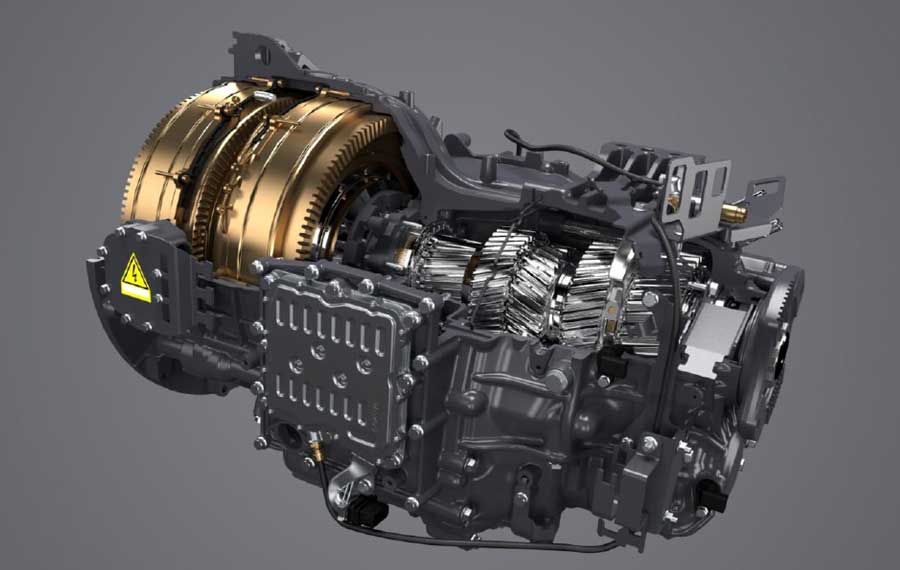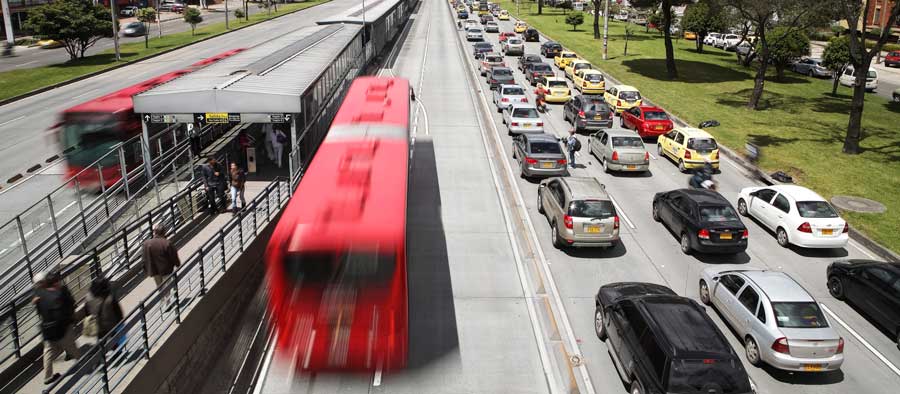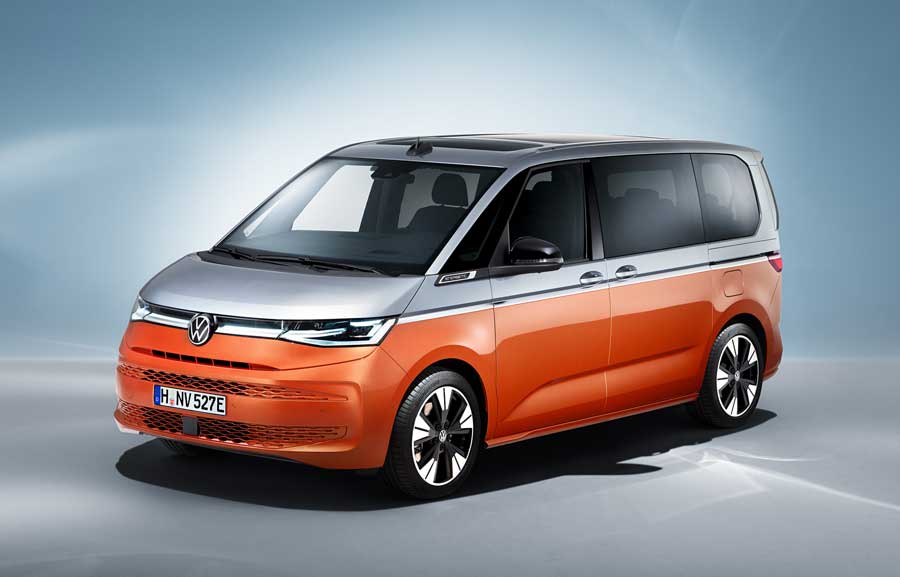Scania is introducing Hybrid Electric Vehicles (HEV) and Plug-in Hybrid Electric Vehicle (PHEV) trucks that can be fitted with different powertrain and charging options, thus offering solutions that can fulfil various demands for applications such as refrigerated transports, concrete mixers and regional distribution. The truly new electric machine GE281 works in tandem with a Scania seven or nine-litre combustion engine, providing unique opportunities for creating fossil-free transport solutions for heavy trucks with demanding bodywork.
Scania’s new hybrid powertrain has been developed in-house according to the company’s modular philosophy. By coupling two electric motors with each other and merging them with essential parts of Scania’s latest (2020) Opticruise gearbox generation, something truly new and remarkable was created: GE281, a Gearbox Electric machine with seamless power transmission and capacity for dealing with GVWs of up to 36 tons without support from the combustion engine. But it also works the other way: since the electric machine is always supporting the combustion engine at take-off and acceleration, the combustion engine can be downsized in both volume and power output. Hybridisation means fuel savings of up to 40% in city areas compared with traditional powertrains.
“The GE281 is something brand new in the heavy truck industry,” says Fredrik Allard, Senior Vice President and Head of e-mobility at Scania Sales & Marketing. “With this fourth generation of hybrid trucks from Scania, we have reached a point where hybrids are strong candidates for a variety of applications and operations where sustainability and smart solutions are the main priorities. These new hybrids have the capacity for taking on a multitude of tasks and will come out on top in all kinds of relevant comparisons.”
The latest hybrid truck generation from Scania can be ordered as HEVs and as PHEVs, available in P, G and L series cabs. The trucks can be specified as rigids and as tractors. The DC07 combustion engine is available in three power outputs, as is the DC09 engine. All Scania Euro 6 engines can run on hydrotreated vegetable oil (HVO), though some can also run on biodiesel FAME.
Scania’s GE281 offers 230 kW continuously and 290 kW as peak power output, while the max torque is 2,100 Nm. It has six forward gears but no traditional clutch, since a planetary gear takes care of that process, providing torque interruption-free gear shifts. This solution also provides for excellent creep drive capabilities at low speeds and the PTO can be engaged while the truck is moving, in electric as well as combustion engine mode.
“The driving experience can actually be compared with what you get in a passenger car with a dual-clutch system,” says Allard. “And with this solution, we can offer all the support functions that Scania customers are accustomed to, such as adaptive cruise control with active prediction and downhill speed control. Another great improvement with this solution is that the energy recuperation during deceleration is also uninterrupted, which is important since the electric machine is the primary brake source in these vehicles.”

More about hybrid vehicles & hybridisation
Scania is one of the few major OEMs that is committed to offering heavy commercial hybrid trucks. Scania was in fact pioneering this segment as early as 2014, when a first generation was introduced with an electric range of up to two kilometres.
“That range of course sounds meagre today when we are offering 60 kilometres, but it was an important first step for our industry,” says Allard. “With that release, Scania started to teach both ourselves and our customers about the potential for zero tailpipe emissions, silent mode and substantial fuel saving from the hybrid solution. With the GE281, we have reached a new level. The electric machine equals or often exceeds what the combustion engine can offer, thus creating the opportunity to downsize the internal combustion (ICE) engine and save both fuel and weight. The ICE is only motivated by its capability to offer the range needed when travelling longer legs between different assignments.”
Scania’s new HEV/PHEV generation offers drivability on a new level; not only is it powerful, it also comes with all the options and opportunities that customers ask for. It offers a PTO that can be used while driving, even in full electric gearbox-driven mode. It offers start/stop functionality that eliminates unnecessary idling and it provides support systems such as Scania Adaptive Cruise Control with Active Prediction. It also comes with different drive modes. When the “Power” mode is selected, some extra 100 hp (or 74 kW) is added on top of the combustion engine’s peak performance.
“It is a mature and fully-fledged product,” says Allard. “It offers all the capabilities and functions that you expect from a Scania, while also offering electrification, the opportunity to run the combustion engine on renewable fuels, and substantial fuel savings. We do believe that these kinds of trucks will eventually be replaced by battery-electric vehicles. But until long electric-powered ranges and relevant charging infrastructures are available in all markets, there is definitely a window during this decade for hybrids.”
The PHEV has an installed battery capacity of 90 kWh (3 x 30 kWh batteries), while the HEV version has one 30 kWh battery. The PHEV can be fully charged in 35 minutes when using a 95 kW DC charger. That means the vehicle can be charged at depots and during breaks or loading sessions (so-called opportunity charging). A hybrid truck with a down-sized engine – from DC09 to DC07 – will actually have a payload that is 250 kg higher compared to its ICE sibling; the hybrid will only add a net weight of 750 kg, while one ton of extra weight is allowed for electric vehicles in the EU.
The level of fuel savings that can be achieved from this modular Scania solution differs according to the usual factors, such as the operation itself, how hilly the route is, and how many start and stops there are. The electric machine is always active, but the extra help from it is less useful when at cruising speed on motorways. The most substantial fuel saving is achieved in urban traffic, where some customers will save up to 40%. And Scania also offers regular repair and maintenance contracts for these hybrid vehicles.
Major cities such as Paris and Amsterdam are implementing strict emission, noise and safety zones. This means that progressive haulers who want to stay relevant and competitive are turning their minds towards fossil-free and electric solutions that are available here and now.
“These Scania hybrids are a smart way to make great strides towards full electrification and a sustainable transport system,” says Ema Ceco, Product Manager e-mobility, Scania Sales & Marketing. “They also offer the best of what is available today when it comes to flexibility and usability. The engines are equals from a power-output perspective. Using only the electric machine in sensitive urban areas does not mean you suffer from a loss of power. For instance, a Scania L 280 6×2*4 PHEV would make for a perfect city tipper in dense urban areas; fully capable of running in electric mode where zero emissions and noise levels below 72 dB are required.”










